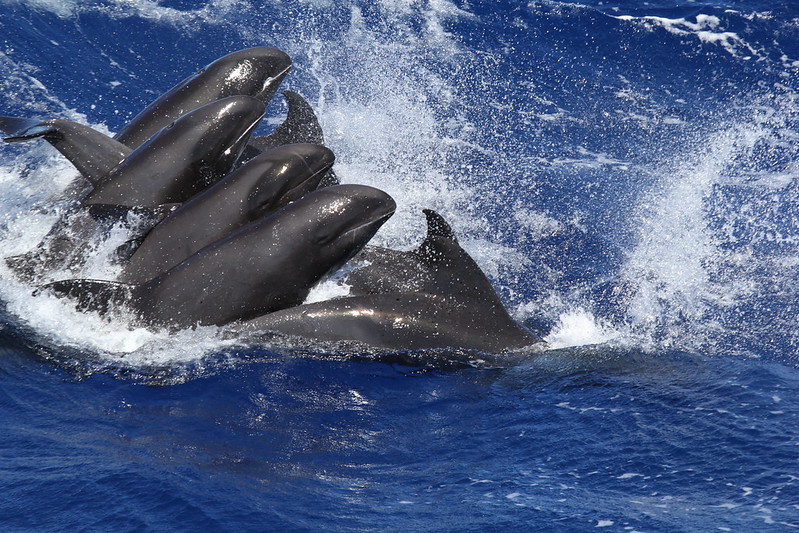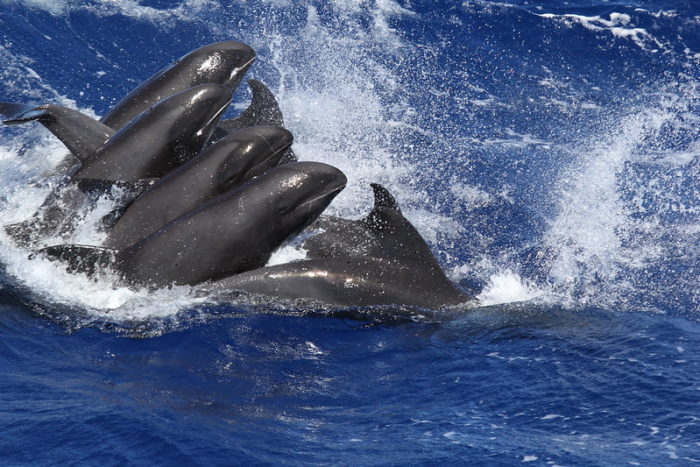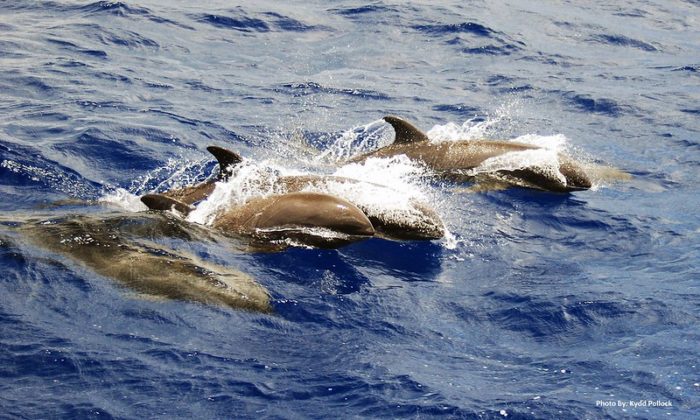
Sea Wonder: Melon-Headed Whale

Melon-headed whales in Hawaiian Islands Humpback Whale National Marine Sanctuary. Photo credit: Laura Morse, NOAA/NMFS/PIFSC
Description
Don’t let the name fool you – melon-headed whales (Peponocephala eleectra) are actually part of the dolphin or toothed whale family. They are aptly named for their small heads with large melons, oil-filled foreheads that allow them to echolocate or see with sound.
Unlike many other dolphin species, melon-headed whales do not have discernable beaks also known as rostrums. Their faces are decorated by white markings which serve as a stark contrast to their dark bodies, which have darker patches along the dorsal cape and near the eyes.
The average size of an adult melon-headed whale is nine feet with adult males achieving longer measurements than adult females. The average weight of an adult male is 460 pounds; adult females weigh closer to 400 pounds. Melon-headed whales closely resemble and are often mistaken for pygmy whales and false killer whales.
Diet and Habitat
Melon-headed whales have a varied diet primarily consisting of small fish, squid, and shrimp. Like many other marine mammal species, melon-headed whales are what is known as opportunistic feeders, meaning they eat whatever is available and easiest to catch. This species’ foraging behavior is known as ambush feeding, a strategy that involves groups of whales chasing large groups of prey and trapping food in their teeth before swallowing it whole. They are nocturnal feeders, so they are the least active in the morning and participate in social behaviors into the afternoon.
Melon-headed whales live in deep, subtropical latitudes in the global ocean. In U.S. waters, two melon-headed whale populations exist: one in the Hawaiian Islands and the other in the Gulf of Mexico and the southeast Atlantic. Very rarely are they seen nearshore. In the National Marine Sanctuary System, this species has been seen near Hawaiian Islands Humpback Whale, Flower Garden Banks, and Florida Keys National Marine Sanctuaries as well as Papahānaumokuākea Marine National Monument.
Life History
Melon-headed whales often gather in large groups of hundreds and even thousands of individuals, though it is common for smaller subgroups of no more than a dozen individuals to be closely bonded and break away from the larger group on occasion. These whales maintain a matrilineal social hierarchy, which means adult females and their calves travel together and males form closely knit subgroups that meet up with female groups throughout the year. Like other whale and dolphin species, melon-headed whales live in fission-fusion groups, meaning individuals join and leave social groups frequently.
A melon-headed whale pregnancy lasts nearly 12 months with adult females capable of giving birth every three or four years. Calves are born tail first so that their blowholes are the last thing to touch the water before they swim to the surface to take their first breath. At birth, calves are nearly three feet long and weigh between 20 and 30 pounds. Calves nurse from their mothers for most of their first year of life and begin learning how to find and eat solid foods at around six months old. At around two years old, juveniles are forcefully weaned and gain their independence from their maternal social group. Melon-headed whales reach maturity when they achieve their full individual body size, which is around seven years old for females and between 12 and 15 years old for males. The maximum lifespan of melon-headed whales is thought to be around 45 years, though the average lifespan is much shorter at about 25 years old.
Threats and Conservation
There are three major threats that melon-headed whales face, challenges that they share with most other species of whale and dolphin. They are: fishery interactions and entanglement, ocean noise, and pollution. The species is targeted by drive fisheries in smaller island states, though they are more frequently harmed by fishing gear like nets. Underwater noise used for military and energy exploration projects interrupts melon-headed whales’ echolocation, navigation, and vocalizations, which often leads to injury or group strandings. Chemical pollution – especially concentrations of forever chemicals like polychlorinated biphenyl (PCBs) – in the ocean can be toxic to melon-headed whales as it accumulates in their thick blubber layer and can be passed along to calves through a mother’s milk. Climate change poses a longer term threat to the species’ success due to changes in prey availability and ocean temperatures.
NOAA has taken conservation action to help protect this species by minimizing noise disturbances, responding to stranded melon-headed whales, educating stakeholders about the whales and their conservation, and monitoring population health and geographic distribution.

Photo credit: Kydd Pollock/The Nature Conservancy
